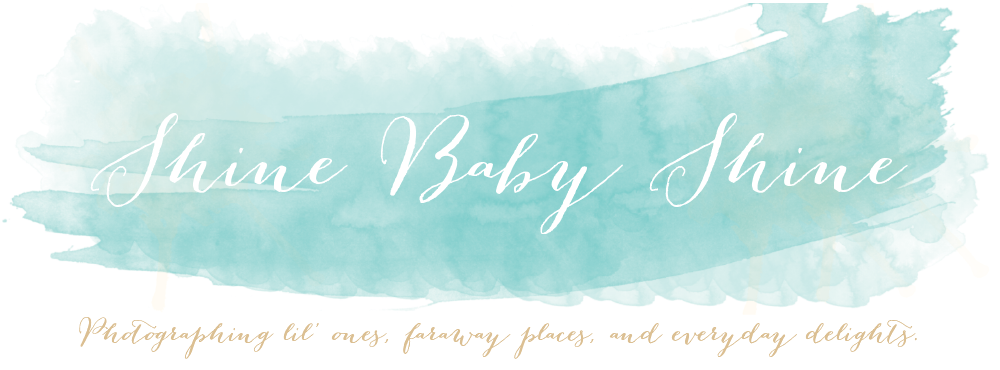Taking pictures of non-moving subjects can be hard enough, but throw in a moving subject and it's a whole other ball game. The general rule of thumb is to ensure your shutter speed is at least 1/60 of second when hand-holding your camera, but this only really helps with one part of the equation. A blurry photo can be caused by two things: the photographer's movement or the subject's movement. Often times, 1/60 of a second will avoid camera shake but is not fast enough shutter speed to freeze a moving subject.
When shooting indoors it can be a challenge to find enough light to choose a fast enough shutter speed. But this summer, I shot plenty of photos outside, allowing me to experiment with faster shutter speeds. In the photo below, the super fast shutter speed of 1/1250 of a second ensured my little girl was crisp and clear. Could I have ended up with the same sharpness with a slower shutter speed (like 1/400 or 1/250 of second)? Maybe, but I didn't bother risking it. Unfortunately, I still rely on trial and error most of the time to figure out how fast my shutter speed needs to be, in any given situation.
Finally, as you'll see with the two photos below, different shutter speeds can both work, but will change the creative effect (first shot at 1/80 sec, second at 1/3 of a second). Which do you prefer?
When shooting indoors it can be a challenge to find enough light to choose a fast enough shutter speed. But this summer, I shot plenty of photos outside, allowing me to experiment with faster shutter speeds. In the photo below, the super fast shutter speed of 1/1250 of a second ensured my little girl was crisp and clear. Could I have ended up with the same sharpness with a slower shutter speed (like 1/400 or 1/250 of second)? Maybe, but I didn't bother risking it. Unfortunately, I still rely on trial and error most of the time to figure out how fast my shutter speed needs to be, in any given situation.
Very fast shutter speeds can create really interesting effects with water. In the two photos below (shot at 1/1250 and 1/800 of a second respectively), I was able to capture movement so quick that even the human eye wouldn't have been able to see it in the same way.
One interesting (and unexpected) thing that I have realized when shooting moving subjects is that sometimes "blur" is a good thing. At times, it can create a more interesting photo than one that was crisp and clear. Take the picture below as an example. On one hand, the photo is a perfectly nice - it clearly captures the joy of my niece's face as she rode the ferries wheel. On the other hand, there is something missing: by freezing all motion, I failed to capture the very thing that caused my niece to smile - the fast, circular motion of the ride.
Panning can help to over come the above problem by helping to convey a sense of motion. Although fairly difficult to master, it involves picking a slower shutter speed and moving your camera in the same direction as your moving subject and shooting continuously (see full explanation in following link). If you get it right, you'll end up with a photo with a sharp subject set against a blurred background.
Here's my attempt at panning on the ferris wheel shot at 1/10 of a second.
Finally, as you'll see with the two photos below, different shutter speeds can both work, but will change the creative effect (first shot at 1/80 sec, second at 1/3 of a second). Which do you prefer?

.jpg)
.jpg)
.jpg)
.jpg)
.jpg)

I prefer the faster shutter speen and crisp focus on the water rather than the blur or 'soft' effect. But the latter is really popular with nature photographers in magazines a neighbour lends me.
ReplyDeleteI learned to freeze action when Katie was in gymnastics, handicapped by the fact that it was all film in those days and it was hard to buy film faster than 400. (And pricey). What I could do is use b&w 400 and 'push' it to 800, thus giving me a chance to stop the action with a knowledgeable pan. Only watching each movement and routine over and over would show me where the good 'stops' occurred.
I did a lot of freeze action shots in good light with the kids when they were little - you really have to read the light levels ahead of time to set the shutter speed and aperture properly. I used F16 a lot. And you need to set your white balance down if you are shooting on snow or sand.
However, I think this type of photography is the most fun of all and you never know exactly what you are going to get. With limitless ability to shoot over and over, you are only faced with coaxing the wretched kid to let you take lots of shots. When Audrey was three or so she rebelled and I got a lot of scowls or raised hands. I have some very weird angle shots when I had the camera in my lap or other spots when she couldn't see it.
And I think I have said that I learned to keep the camera where I could grab it immediately.
I am loving this series you are doing Kira and so impressed with some of your results.
speed. Grr.
ReplyDeleteWatch out for 'grain' in really high speeds, unless your lens is super good.